Episode #415: When Fidelity in Math Improvement Turns Into Rigidity & How To Avoid This Costly Mistake
LISTEN NOW HERE…
WATCH NOW…
Implementing with fidelity matters—whether it’s adopting a new math resource, embedding a routine like number talks, or structuring PLCs. But fidelity is not the same as rigidity. When we cling too tightly to practices, they can outlive their usefulness and prevent innovation.
In this episode, we draw from research, including Janice Fraser’s concept of making durable decisions, to unpack the balance between fidelity and rigidity in math improvement. We explore how leaders and teachers can commit deeply enough to see results without locking into approaches that may no longer serve students.
We also examine what it means to hold strong beliefs, loosely held—anchoring commitments in evidence-based math practices while staying open to refinement as new learning emerges.
Listeners will learn how to:
- Distinguish between fidelity to outcomes and rigidity in practice.
- Apply research on durable decisions to math routines and systems.
- Use fidelity as a lever for student achievement while leaving space for adaptation.
- Recognize when it’s time to refine, pivot, or let go of a practice.
- Model “strong beliefs, loosely held” in leading math improvement.
Tune in to discover how to implement with fidelity without getting locked into rigidity—so your math improvement efforts remain both focused and adaptable.
Attention District Math Leaders:
Not sure what matters most when designing math improvement plans? Take this assessment and get a free customized report: https://makemathmoments.com/grow/
Ready to design your math improvement plan with guidance, support and using structure? Learn how to follow our 4 stage process. https://growyourmathprogram.com
Looking to supplement your curriculum with problem based lessons and units? Make Math Moments Problem Based Lessons & Units
Be Our Next Podcast Guest!
Join as an Interview Guest or on a Mentoring Moment Call
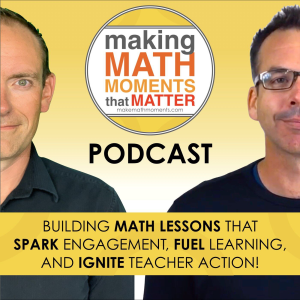
Apply to be a Featured Interview Guest
Book a Mentoring Moment Coaching Call
Are You an Official Math Moment Maker?
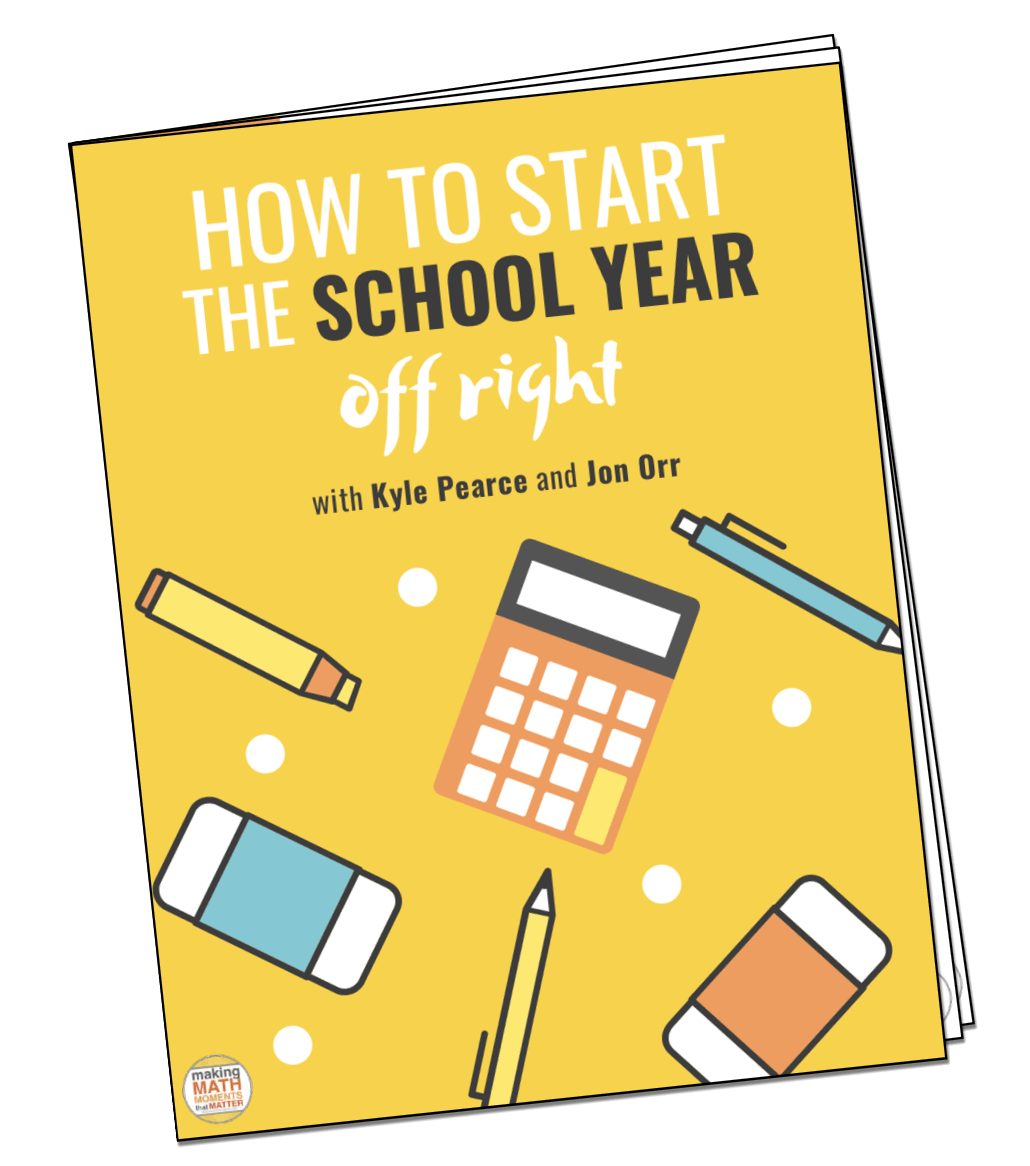
FULL TRANSCRIPT
Yvette Lehman: In the work that we do, think our goal is to always try to do learning to support the districts that we work with closely. And when there are problems that arise, it’s like, how can we help them, unpack them? What’s the research say? How can we refine our own understanding of what math improvement looks like? And so last week I encountered a big idea. And the big idea that came up in some of the conversations with our district partners was this idea of fidelity versus rigidity.
Jon Orr: Hmm, yes. Yeah, like, I guess I think I, I’m just gonna jump in because I think I know what you’re, you know, the fidelity of the curriculum is like the new catchphrase this last few years, which, you know, in terms of leadership, in terms of coaching, in terms of, you know, support at schools and across districts, it makes sense. It’s like we’ve got these curriculums, they’ve designed a very particular way with with best practices in mind. We want our teachers, like we hope our classrooms are using the tools the way they were designed to be used instead of just saying, I’m gonna use it as a pacing guide and do what I was doing, which maybe still isn’t maybe perfectly a good fit for student learning in your classrooms or working with individuals in their actual classes. So I get the whole like, you know, we got to be teaching with fidelity. But then you’re right, there’s like the spectrum, right? It’s like, am I flexible? Like am I teaching with flexibility? Am I following what this looks like? But then or am I being too rigid? Like am I am I not actually like using it the way it was really intended, which is probably to get you know, allow you to listen more to your students. And then you’ve been just following the letter of the law, you know, I follow this exactly the way it was intended. And if a coach or coordinators like, yes, We should all be following exactly the way that we say. Like I get this dynamic because it’s like how much leeway should we be giving our teachers?
Kyle Pearce: Well, well, and the part, you know, and I can see there’s, there’s places where things are very rigid and you can walk into a classroom and it’s like, you can almost hear that pages all turn at the same time and you hear it in unison through at a building, but it doesn’t necessarily mean that everyone’s doing it for the right reasons. Right? So you can, you can have it super streamlined, super aligned, no autonomy, but sometimes that can completely shut down thinking for the educator. Right. And it really, to me comes down to this idea of, professional judgment that you want to allow our professionals to utilize professional judgment, but we want to make sure that they actually understand what that means. And professional judgment to me means that you’re actually, you’re clear on what it is that we’re all working towards. And if I use my professional judgment and I feel that I can help get there a little bit more effectively or, or, you know, a little more efficiently, it would make sense to do so if it means helping to get to the result clearer, faster, and smoother. It’s not about just going, feel differently about what this should look like and sound like in my classroom, and therefore I’m gonna go off and do something incredibly different.
Jon Orr: Yvette, where do you see the rigidity part here creeping in?
Yvette Lehman: And I think that before I get to that part, I want to be clear that I do think fidelity matters. So like, I do think that when we’re supporting the implementation of a new resource or a new routine, we can have people improvising off the bat. Like I think that, I think that it’s like most people shouldn’t be improvising from the beginning. Honestly, like I think that when we’re first learning something new, our first go at it might require us to be consistent.
Kyle Pearce: Right, well doesn’t improvisation almost mean it’s like you knew what it is intended to look like and now you’re improvising, but if you don’t know what that looks like yet, you’re not really improvising, you’re just making stuff up as you go.
Yvette Lehman: Right. You’re making exactly. Right, so I think like there is something to be said about, you know, the first time we implement something or the first iteration, let’s say, like, let’s say it’s the first iteration, we’re new to problem strings, we’ve picked up Cathy Fosnows mini lessons book, I think the first iteration we want to create establish a common baseline, you know, we want to get some indicators of what it is and what is isn’t. But also I mentioned that idea of like iteration, that like we’re constantly coming back around and reflecting and talking about what’s working, what’s not working. And so I think that you mentioned like when does rigidity come in? It’s like when we’re so stuck on, well, the book said to do it this way. And even though it’s no longer serving our students and it’s no longer serving our teachers, we’re not willing to let go of, well, it’s said to do it this way. And it’s like, we can see, you know, engagement is down. We can see that students are understanding. We could see that the teacher is, you know, losing interest or no longer has buy-in, it’s like we’re still stuck. An example that I thought of is even in like teacher collaboration time or PLC is like, imagine we wanted to support the implementation of a particular protocol in PLC. So this isn’t even just in the classroom. It’s like as a district, we’re gonna put this PLC in place. The first time through, we might wanna use the protocol, like start to finish, right? Like it’s like, we’re actually gonna follow every step of the protocol. But then after feedback and after trying it, the teachers are like, well, this part’s redundant or we’re taking too long on this part and it’s not really serving our purpose. We’re gonna cut this part out because we get back to that same idea later in the protocol. But rigidity would be the principal saying, no, we have to follow every step because that’s what the document tells us to do.
Jon Orr: Hmm. Yeah. Right.
Kyle Pearce: Right. And that’s where I see that this is where that professional judgment really needs to live is within why isn’t it having the impact that we’re wanting or that maybe the research suggested or whatever it is. And or how is the situation different where we’re in a different testing ground than it was in the research we read or the book we read. Right. And those are the things that I think It’s, say it all the time. It’s like this on off this digital mentality as humans. It’s like, want to be a hundred percent rigid or we want to be a hundred percent free flowing. Right. And ultimately it’s somewhere in the middle where we want to make sure that we’re actually giving it the best shot we have without just sort of aimlessly following without thinking. Like you have to, you have to get on a, on a, you know, on the right path. in order to experience and see what’s working well and what’s not. And then from there, making some intentional moves to try to pivot. And we’re not talking about 180 degree pivot here. We’re talking about just little things that may or may not be helping us to get to the place we wanted to get to through that protocol.
Jon Orr: Yeah. Well, I think you just, you just said it and, and, and you’ve had had just said it a minute ago about like, were like, the rigidity was creeping in and it was like, we’re realizing that we’re not getting to where we want to go. Like, and you just said the pathway to where we want to go. Like we have like, are we, are we being clear on where we want to go? You know, I think that’s because that’s the important part here, you know, like it’s the routines are going to come and go. And I think the important part is clarifying where do we see, like what is the reason here? Like what is it that we’re really trying to do? Because that’s what’s really gonna be allowed you to strive away from the rigidity or stick to the rigidity. know, if like you’re in that PLC vet and it’s like, well, you know, the book says we’re doing this, but it’s like a teacher’s like, well, wait a minute, but this is actually trying, you know, we can accomplish the same thing, goal, by doing it this way versus not that way. That’s where like you now, if you have not yet had that PLC discussion about like, what is the, what is the goal here? We got to do that. Like that’s otherwise what are we, what are you doing?
Yvette Lehman: Well, that’s what led me down the rabbit hole this week around what do we do to avoid getting in these situations where it’s like now we feel like we’ve implemented something with fidelity, but also with rigidity. And now we feel like, we can’t go back on what we said. You know, we have to stick to the plan. We have to stick. This is what we put hours into this. And even though it’s no longer serving us, we feel married to it because we approached it maybe not in the best way from the start. So I wanted to figure out like what has to happen at the beginning of this journey so that we find ourselves positioned to be both you know implement with fidelity but without rigidity.
Jon Orr: Yeah, like I think part of it, and I know that you’ve got some tips to share from the learning that you’ve been digging into, but I mean, even part of it is just knowing that it’s going to change. know, like going into being like, we’re gonna stick to this rigidity and we’re gonna stick to the fidelity of the program. I get it, but it’s like, well, we also know that things will change. you know, with new information, things will change. And we’ve talked about it here on the podcast before too, is like, you can have strongly held beliefs on where you wanna go, but you gotta loosely hold them. Otherwise you’re in that situation that you just said, like you’re like, at the beginning of the year, we’re gonna do this every week and thou shall not change. And then wait, wait a minute, I’ve got new learning that I didn’t know before. And now that actually impacts what I would do differently, but I can’t go back on my word. What happens? What will it look like if I tell them, all that really important stuff I said, don’t do now we got to do it or, or the opposite. you know, we got to do that, but maybe we shouldn’t be doing that anymore. You know, like, like that’s like, if that recommendation has to be in there, right? It’s like, no matter what you do at the beginning of the process is know that it’s going to change and hold those strongly held beliefs, but loosely hold.
Yvette Lehman: In my research, I came across a book from Janice and Jason Frazier, and they aren’t specific to math education or education. They’re actually, you know, on the business side of things from Northern California. But they wrote a book around leadership moves, essentially. And, you know, they did 20 years of research on what do strong leaders do? Like, what are some of the behaviors of these strong leaders? And the book’s called Farther, Faster, and Far Less Drama. And they essentially have four leadership motions that they highlight in this book. I don’t want to speak too much of the book because I’m not an expert on it, but I am going to give us like a high level overview at this time. I’ve done one, one listen through, I need to go back again and do another. There’s also some podcasts out there where Janice Frazier is interviewed on these leadership motions that people want to start there. But I, I came across this idea of like, rather than being reactive, how do we proactively create a system where we can have fidelity, we can have coherence, we can have alignment. but also that space, as you mentioned, for innovation, for change, for iterations and reflection. And so they identify essentially four motions. The first one is orient honestly. The second is leverage the brains, value outcomes as one, and then make durable decisions. So we’re gonna unpack those a little bit. Durable decisions, yes. We’ll unpack them a little bit and talk about how they may help us avoid this situation that we’re describing.
Kyle Pearce: Ooh, durable. I like it.
Yvette Lehman: So Orient, honestly, the way that I interpreted it for the math education context, so not necessarily the business context, but our context is like, we need to understand and have an honest look at where we are currently. And we say this all the time to our district leaders. It’s like, you need to get a pulse on your system. You need to write, like get into classrooms, talk to teachers, talk to students. Like we need to have an honest look at where we’re starting from. An example of this is imagine that, you know, research tells you that talk routines are really a great move for your classes. And so you do this heavy push of talk routines and you’re like, this is what talk routines should look like, sound like in your classrooms, but you don’t take into account that, you know, half of your classes have multi-language learners who are going to need like adaptations to this implementation. So it’s like, if we’re not taking into account our context and where we’re starting from, that’s problematic. So that’s like one of the things is like before we go down this road is like we need to have a really good understanding of recognizing our current restraints in our current conditions so that we can be responsive through the journey.
Jon Orr: Yeah, yeah. And I think leveraging the brains speaks to what we try to support our teams with when we talk about Keith Farazzi’s work on co-elevation is that we need to trust the people that we’re working with and we need to bring them into those conversations. We need to co-elevate the leadership that exists in schools, in classrooms, in districts, and make them parts of our team and make sure that we’re building in the vision that we’re trying to equate. This is gonna go to the next part too, but that example where we said is like, we don’t know the clarity of what we’re trying to do, then how do we trust the teachers that they also have so much expertise on what they do? And what we do, as we’re all classroom teachers, and it was like, how much trust would we have if you come in and say, well, we’re gonna do this, this way? It’s like, we have to trust that we are experts in what we do, and we have expertise that can help guide this situation. We have to trust that. that we are going to make good decisions when we know what those outcomes are, which I think leads into that third one, which is valuing those outcomes.
Yvette Lehman: feel like when I read this section, or actually I listened to this section, I felt like it maybe confirmed what we’ve been saying, which is like, it’s about the change you want to see. It’s about the outcome. It’s not about sticking unwaveringly to a plan. So if the outcome you want is increased student fluency, right? Like if you want to see a change in your student’s ability to, you know, engage with the four operators with flexibility to show automaticity. If that’s the outcome, the plan may adjust and change depending on the students in our classrooms along the way. Like what works now may not work 10 years from now, but the outcome is where we are unwavering.
Kyle Pearce: Well, and the part I think that’s really important there is to make sure that we are willing to adjust as we go, but not throw it all out. Right? And I think that’s the part where we get stuck again in this all in, all out sort of mentality. So we have a plan, we want, it’s like if we know the outcome and we see it’s like, we make an adjustment, we can get there a little bit better, a little faster, a little sooner, a little more efficiently. That’s a worthwhile change to make, but what isn’t is when we try to just start something brand new, which often happens, right? We see it’s like when things get tough with a current plan, we start thinking like the entire plan needs to change. And that’s where I think that leads into the last piece here, making durable decisions. Like I like the word durable because if we make durable decisions, that makes these adjustments work without it breaking. the original plan, like without it breaking the original goal, vision outcome, it allows you to make it better. And I think with these small changes, it actually makes it more durable if we’re willing to be a little flexible, right? And I’m picturing like something that’s durable. It’s like you can flex it a little bit and it’s not gonna break. It’s not gonna shatter. And with our plans that we’re using within our districts, I think that’s something that we have to just be cautious about that we don’t. You know, we don’t want to just smash the plan and start from scratch. We actually want to adjust it as we go and just make little movements that we can make that might have a better impact based on where we are now compared to where we were when we started the plan.
Yvette Lehman: When they talked about this idea of durable decisions, really liked it. The two problems they were trying to address was like the non-decision, where it’s like we actually do nothing because we can’t come to a consensus. So that’s like the problem, you know, for moving forward. The other extreme that they described was basically you come to a decision, but people don’t believe it in it. So they just keep doing whatever they were doing before. And actually they talk a lot about the word buy-in and there’s some, know, thinking around the word buy and they talk more about like alignment, I guess, which is a word that we use as well. So when they say that the problem they’re trying to address within organizations is either like no decision being made or a decision has been made that people don’t, no change results from it. And so they talk about leveraging two questions for decision-making. And the first question is like, does this move us toward our outcome? So is this going to help us get closer? to what we would call our objective, our focus zone. So if it’s student fluency, like is this gonna help us better prepare our students to build automaticity and fact fluency? And I love the second question, which is essentially like, can we all live with it? So it’s like, even if we don’t all agree with it, can we all commit to it anyway? Knowing that we’re gonna get feedback, we’re going to hear how it’s going, we’re gonna be open to modifications and changes along the way.
Kyle Pearce: Well, I think that’s a really important piece. when John, you said buy in and like once like buy in isn’t just accepting something, it’s like truly believing that it is a good move. Right. And I, I’m, what I’m hearing you say that is like, if we can get people to, and I think those two questions help you to land there where you go, like, is this going to help or hurt? And if it leans us more towards helping it’s hard for someone not to be able to at least buy into the idea that this is going to do better than worse. And that’s where you start to get people trusting and maybe committing more to, you know, not pushing back. Cause where, where I think we see things go wrong is when someone doesn’t buy in, sometimes what you get is actually someone pushing back and actually like doing like the, you know, becoming a saboteur, you know, saboteur. to the plan because they like disagreed with it fundamentally for some reason. So I think by asking that question and making sure like everybody kind of lands there and if they don’t land in it helping more than hurting, then going down that rabbit hole to better understand it I think is really important which kind of goes back to the second point around leveraging the brains, right? Like you’re giving people an opportunity to share. their thinking so that we can get clear on what this could or should mean for us moving forward.
Jon Orr: What I like specifically about those two prompts is I think one is it addresses that main concern about that example of like, what happens if I have to go back and change things? If you start with those two prompts in mind before you even begin, you’re gonna satisfy, you won’t be in that situation. You’ll know that you went into it knowing that we’re gonna have the iterations, knowing that we’re building off expertise, knowing that we’re gonna pivot, knowing that we’re gonna make sure that we are being, working with fidelity, but we’re not as rigid as we could be. And the commitment part is that second piece that I was thinking is like, I would even add a third prompt here. It’s like, can we all live with it? And then maybe even the side question there is like, can you specifically commit to? Is it like, you might disagree with it, but what can you commit to here if we know that we’re trying to get to that outcome over there? Like you’re already doing this in your classroom and this in your classroom and you know you’ve got this to do and this to do and you’ve got this student over here that’s high needs. You’ve got this thing that we, on this initiative and in a different subject and not math. What could you commit to knowing that that’s the outcome or after going down this pathway with these resources or with this particular resource? And then we’ve talked, you know, so. you know, in some of our live presentations, but also I think here on the podcast, we talked about commitment cards as a, as a tool that can actually, you know, help us, which is like us writing down, like what can I commit to? And then passing it to a peer. And then they pass you a card back and we hold that till the next PLC or we hold that until the next time we meet up and say like, this is what I was committing to. How we do, how do we do on that commitment level? The next time we revisit each other, it can be a powerful tool to kind of like commit to the the actions that you’re willing to commit to. Those durable decisions are, I think, so important.
Yvette Lehman: think we have some, you know, kind of maybe guiding ideas for our leaders who are listening today. So it’s like, what was my, you our big learning from this particular episode? And for me, it’s like always returning to the outcome. So like, that’s what orients us, that’s what guides our decision-making. The other one is like, we have to build in cycles for reflection, refinement, and new iterations. And I think coupled with that is like this idea of highlighting. or celebrating teachers who are flexing or changing while keeping the spirit of fidelity intact. So it’s like, can we highlight examples, like good examples of a teacher who took the implementation of this particular strategy or resource with fidelity, but then found opportunities to innovate, found opportunities to make it more responsive and actually highlighting that, like not making it so that we think that the best. rollout of this particular resource or strategy has to look and sound exactly the same way. And I really like this idea, which is, you we talked in a previous episode about our bridges. So our bridges, right, are our principals and our coaches and our department chairs and our teacher leaders. And it’s like, we need to help them also see or distinguish, like, what does implementation with fidelity look like? But then when does rigidity creep in? So yes, we want you to support the implementation of this PLC protocol, but does that mean we have to be lockstep every single meeting, every single department, every single grade level needs to look exactly the same in the second, third and fourth iteration? I feel like no, like we need to establish a baseline, we need to build in routine, but we also have to create a space where we can be responsive.
Jon Orr: Love it, love it. So, you know, some of those guiding principles are anchor back to the outcomes, you know, expect the iteration plan for the iteration, support your bridges and celebrate the that you are going to make. And those are some key moves I think we can all make when we’re supporting the wonderful educators that are helping our students learn math at a deeper level. If you want to dig in a little bit more into your math. program planning and you need some guidance along the way, reach out to us over at makemathmoments.com forward slash discovery. We’ll glad to have wanna call and talk about your programming and how we can support you in the work that you’re doing this year and next year on the elements we talked about here today. That’s makemathmoments.com forward slash discovery.
Thanks For Listening
- Book a Math Mentoring Moment
- Apply to be a Featured Interview Guest
- Leave a note in the comment section below.
- Share this show on Twitter, or Facebook.
To help out the show:
- Leave an honest review on iTunes. Your ratings and reviews really help and we read each one.
- Subscribe on iTunes, Google Play, and Spotify.
DOWNLOAD THE 3 ACT MATH TASK TIP SHEET SO THEY RUN WITHOUT A HITCH!
Download the 2-page printable 3 Act Math Tip Sheet to ensure that you have the best start to your journey using 3 Act math Tasks to spark curiosity and fuel sense making in your math classroom!
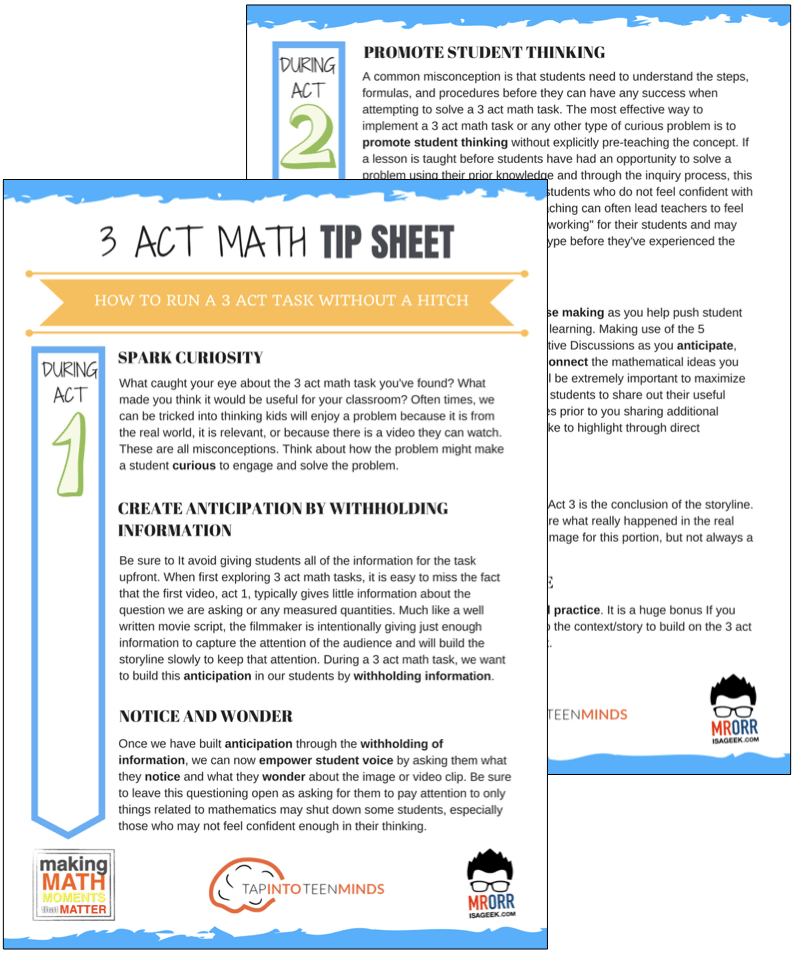
LESSONS TO MAKE MATH MOMENTS
Each lesson consists of:
Each Make Math Moments Problem Based Lesson consists of a Teacher Guide to lead you step-by-step through the planning process to ensure your lesson runs without a hitch!
Each Teacher Guide consists of:
- Intentionality of the lesson;
- A step-by-step walk through of each phase of the lesson;
- Visuals, animations, and videos unpacking big ideas, strategies, and models we intend to emerge during the lesson;
- Sample student approaches to assist in anticipating what your students might do;
- Resources and downloads including Keynote, Powerpoint, Media Files, and Teacher Guide printable PDF; and,
- Much more!
Each Make Math Moments Problem Based Lesson begins with a story, visual, video, or other method to Spark Curiosity through context.
Students will often Notice and Wonder before making an estimate to draw them in and invest in the problem.
After student voice has been heard and acknowledged, we will set students off on a Productive Struggle via a prompt related to the Spark context.
These prompts are given each lesson with the following conditions:
- No calculators are to be used; and,
- Students are to focus on how they can convince their math community that their solution is valid.
Students are left to engage in a productive struggle as the facilitator circulates to observe and engage in conversation as a means of assessing formatively.
The facilitator is instructed through the Teacher Guide on what specific strategies and models could be used to make connections and consolidate the learning from the lesson.
Often times, animations and walk through videos are provided in the Teacher Guide to assist with planning and delivering the consolidation.
A review image, video, or animation is provided as a conclusion to the task from the lesson.
While this might feel like a natural ending to the context students have been exploring, it is just the beginning as we look to leverage this context via extensions and additional lessons to dig deeper.
At the end of each lesson, consolidation prompts and/or extensions are crafted for students to purposefully practice and demonstrate their current understanding.
Facilitators are encouraged to collect these consolidation prompts as a means to engage in the assessment process and inform next moves for instruction.
In multi-day units of study, Math Talks are crafted to help build on the thinking from the previous day and build towards the next step in the developmental progression of the concept(s) we are exploring.
Each Math Talk is constructed as a string of related problems that build with intentionality to emerge specific big ideas, strategies, and mathematical models.
Make Math Moments Problem Based Lessons and Day 1 Teacher Guides are openly available for you to leverage and use with your students without becoming a Make Math Moments Academy Member.
Use our OPEN ACCESS multi-day problem based units!
Make Math Moments Problem Based Lessons and Day 1 Teacher Guides are openly available for you to leverage and use with your students without becoming a Make Math Moments Academy Member.
Partitive Division Resulting in a Fraction
Equivalence and Algebraic Substitution
Represent Categorical Data & Explore Mean
Downloadable resources including blackline masters, handouts, printable Tips Sheets, slide shows, and media files do require a Make Math Moments Academy Membership.
ONLINE WORKSHOP REGISTRATION
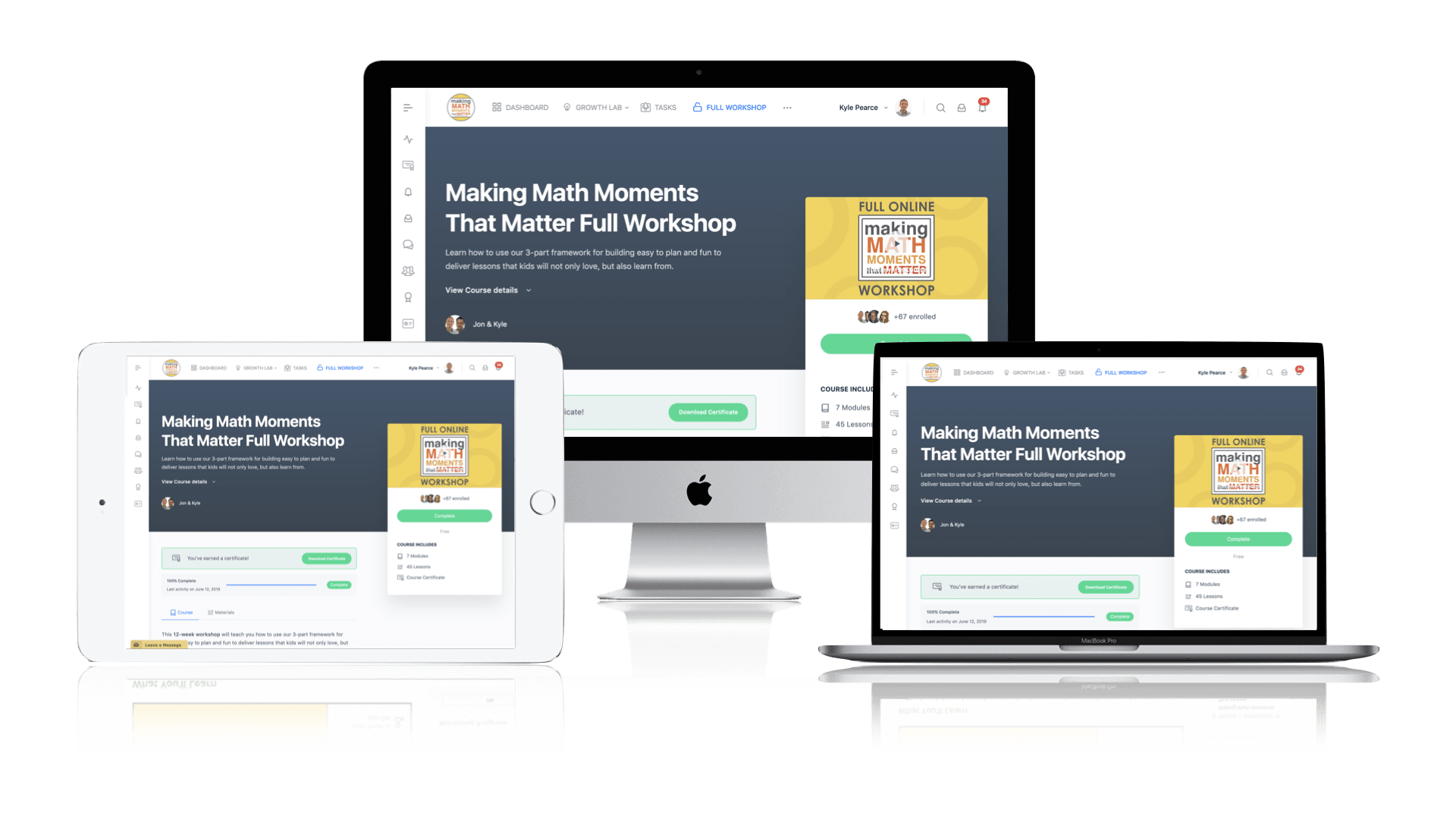
Pedagogically aligned for teachers of K through Grade 12 with content specific examples from Grades 3 through Grade 10.
In our self-paced, 12-week Online Workshop, you'll learn how to craft new and transform your current lessons to Spark Curiosity, Fuel Sense Making, and Ignite Your Teacher Moves to promote resilient problem solvers.
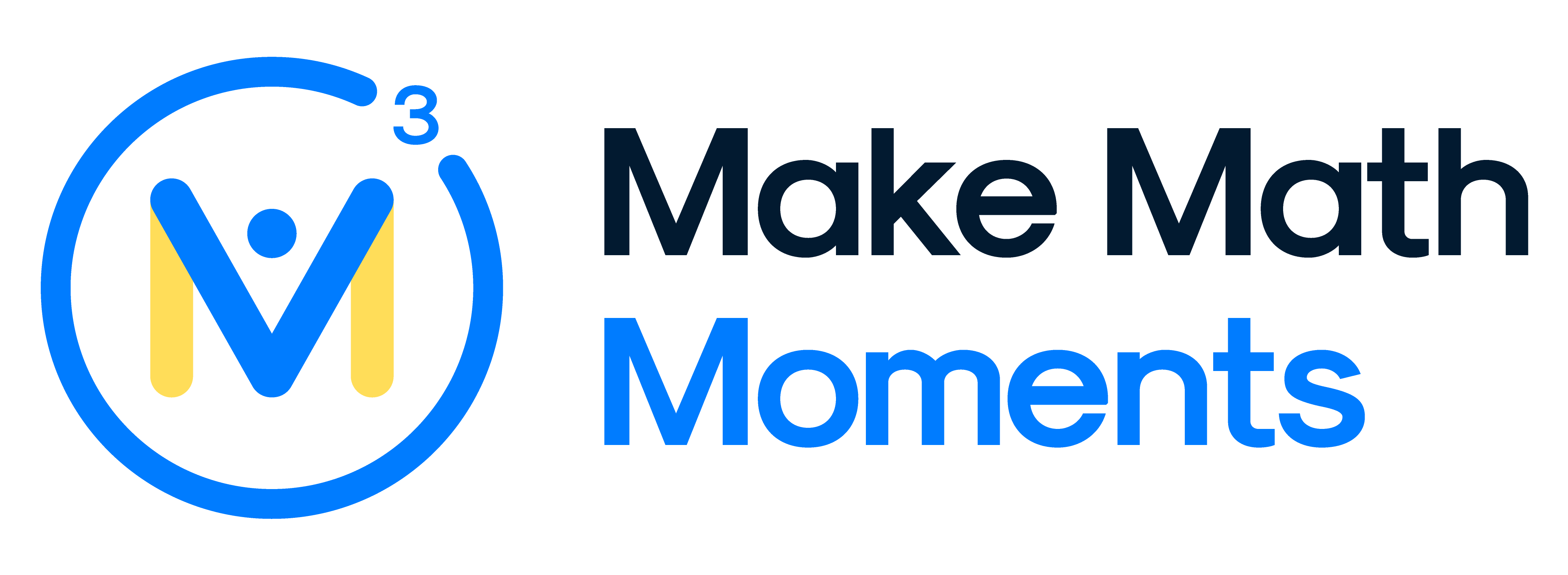
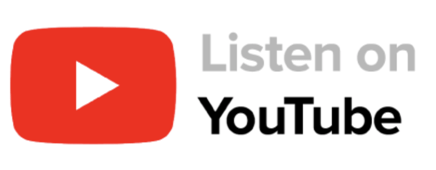


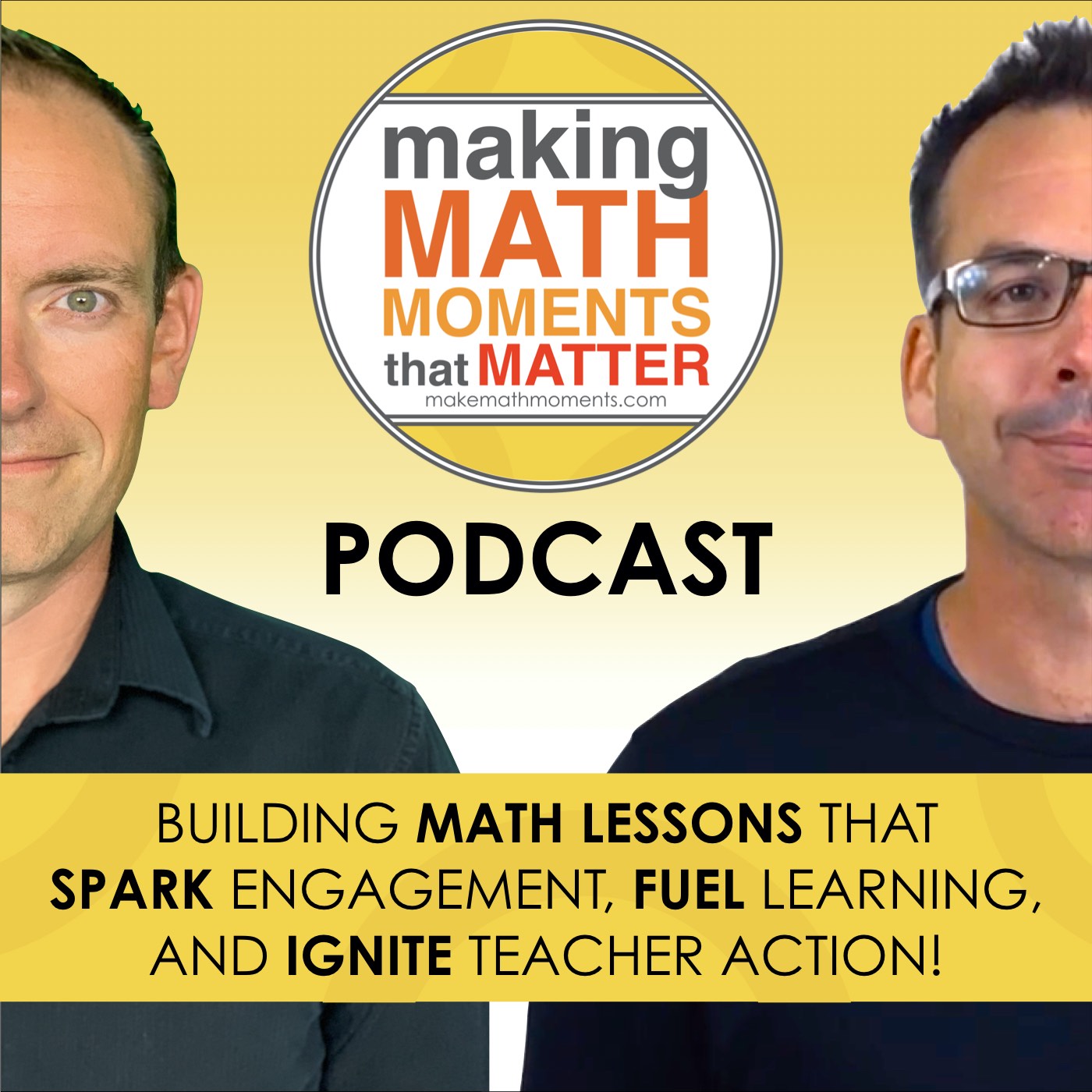
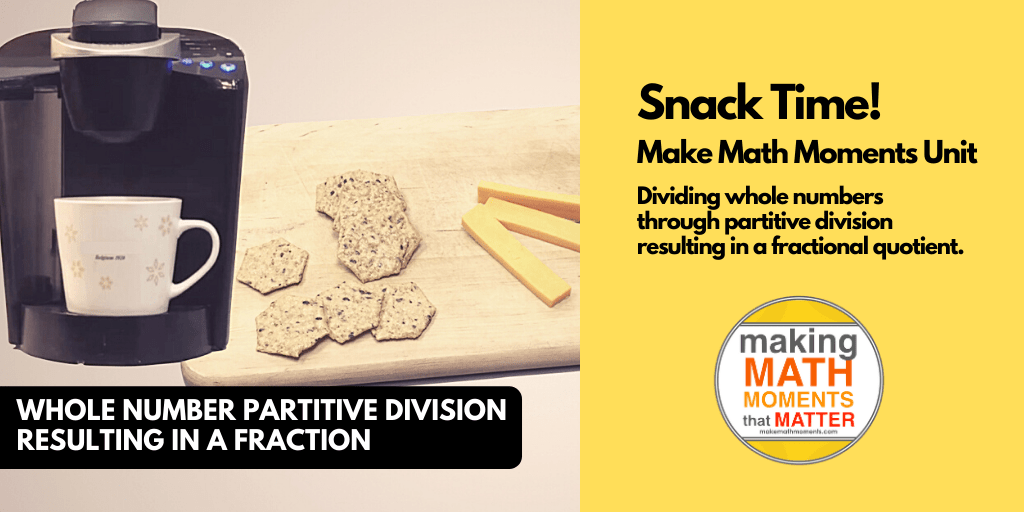
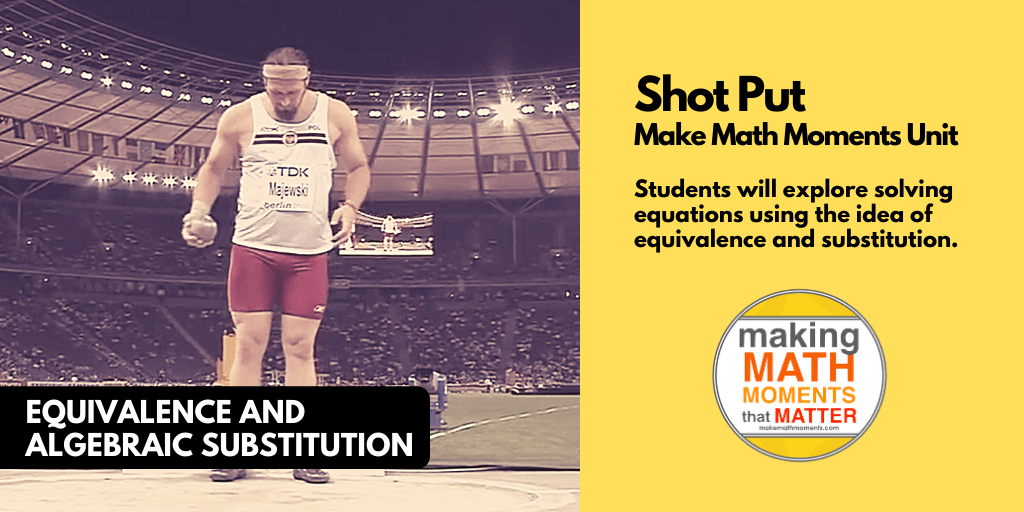
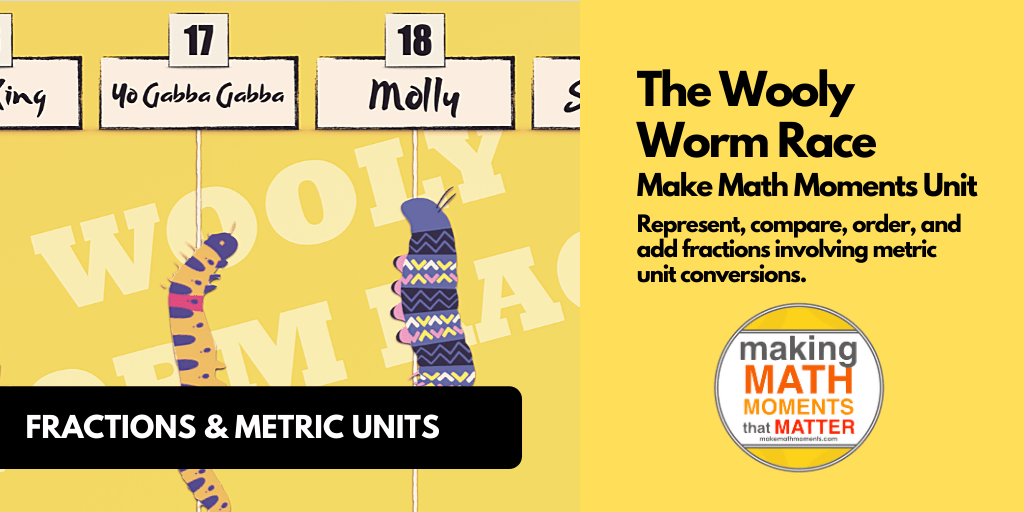
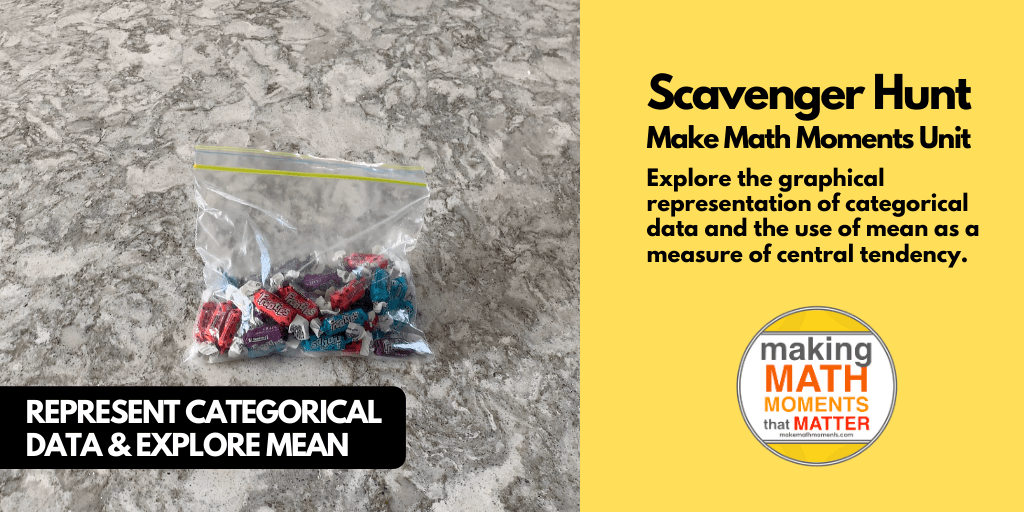
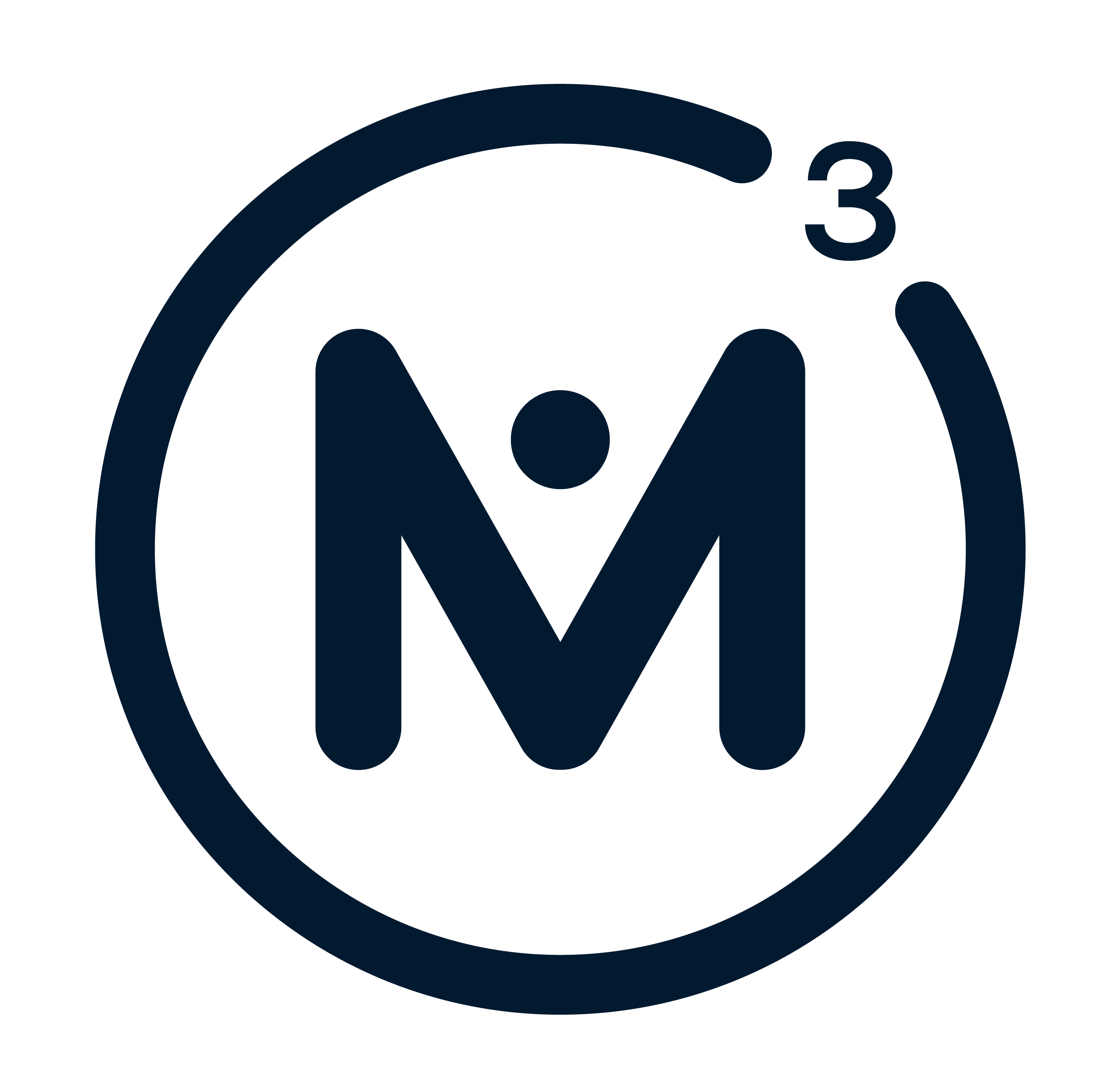
0 Comments